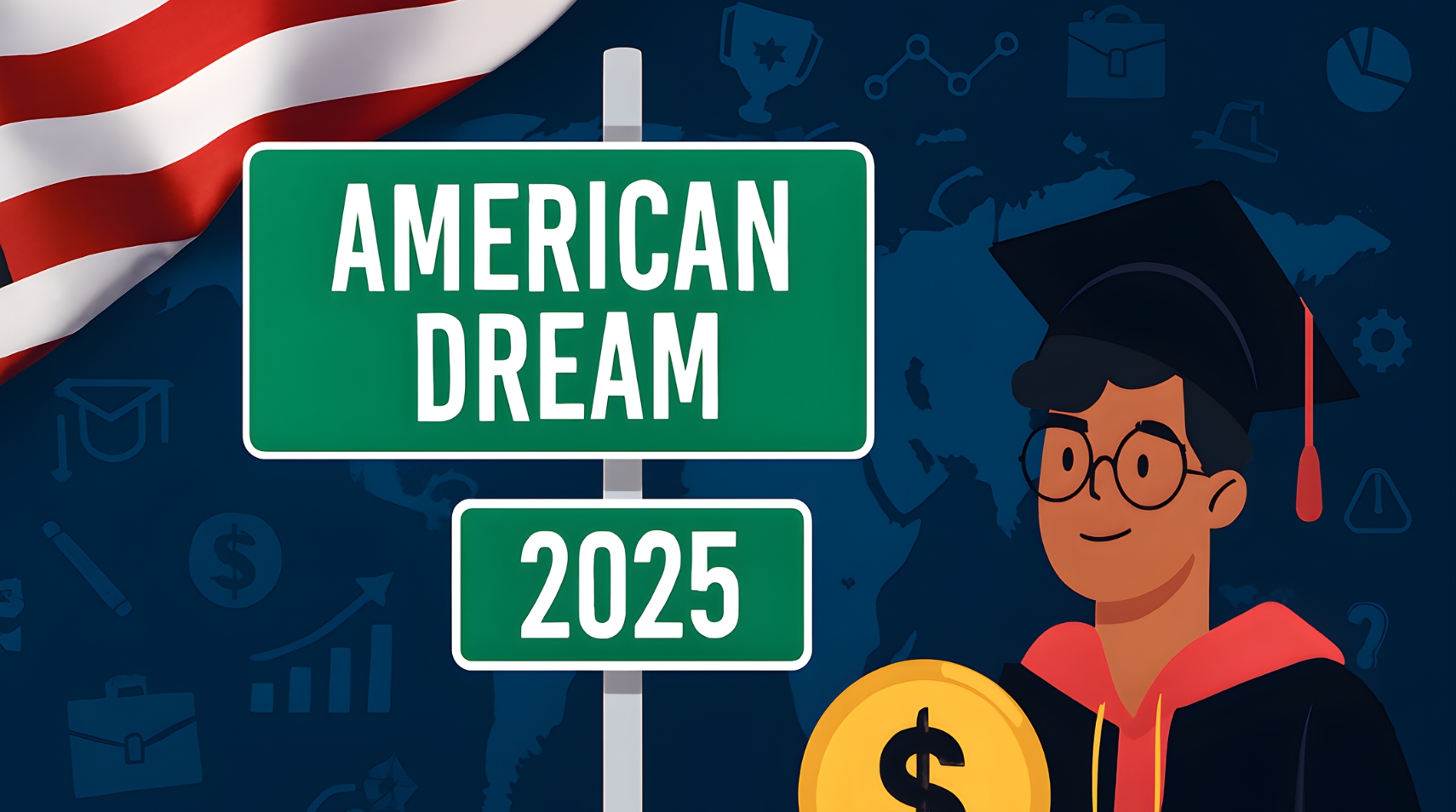Okay let me share a POV to give you an overall context.
An International Student lands at JFK ( John F. Kennedy International Airport) with a backpack, a visa stamp, and a smile he can’t hide. The air smells like jet fuel and coffee. A person who came to pick him up at the airport waves a small flag. Seeing all these, he thinks, this is my fresh start.
Everything feels so fresh, unique and colorful seeing those skyscrapers, food, and the life of people around him. Then the first bills hit. Rent is due, tuition is higher for him, and the campus job only covers groceries. Visa rules feel strict, interviews paused earlier this year, and arrivals dropped 19 percent in August. He hears friends say the job hunt after graduation is tough.
So, is the American Dream still worth it in 2025 for international students? Yes, but only if you go in with clear eyes and a solid plan.
Why chase it at all? Because the country still offers top programs, strong research, and a huge network. STEM paths can open doors like OPT, and some states give rich academic and cultural scenes. Many students build skills, gain confidence, and send money home.
But the hurdles are real. Visas can shift without warning, and schools expect full payment. Cities are pricey, and the hiring bar is high for new grads. Stress piles up fast if you don’t prepare.
This guide gives you a straight look at both sides. You’ll see what’s working now, what’s harder than before, and what steps raise your odds. If you want better jobs, new chances, and long-term options, you can still find them here. Just treat the dream like a project, not a wish.
What Draws International Students to the American Dream in 2025
The pull is simple to feel and hard to ignore. World-class schools, big ideas, and a culture that rewards initiative. You study with experts, build a network that spans continents, and step into careers that pay well compared to many home markets. Even with tighter visa timing in some months, the U.S. still hosts about 1.16 million international students in 2024 to 2025, a sign that ambition travels.
Top Universities and Programs That Inspire
California and New York set the pace. Think Stanford, UC Berkeley, UCLA, CSUB and Caltech on the West Coast. Picture Columbia, NYU, and Cornell Tech in New York City. These campuses mix research, startup energy, and faculty who ship ideas into the real world.
You get hands-on learning that sticks:
Tech and AI: labs, capstone projects, and access to venture-backed pilots.
Business and analytics: case competitions, founder talks, and live client work.
Biotech and climate: wet labs, field studies, and partnerships with hospitals or energy firms.
Want a quick scan of top programs? Explore the latest rankings for engineering, business, and more at the 2025 Best Graduate Schools. For a curated take on international student friendly picks, watch The 10 Best Universities in the USA for International Students by AdviseBridge:
Building a Global Network and Future Career Boost
You sit next to peers from Seoul, Lagos, Berlin, Nepal, Nigeria and São Paulo. Group projects turn into friendships, then into cross-border teams. That mix becomes your global Rolodex.
How it pays off:
Alumni gravity: NYU and Columbia grads fill finance, media, and tech firms across Manhattan. Stanford and Berkeley alumni seed startups and lead labs across the Bay.
Real connections: a data science classmate joins a unicorn, a former roommate lands at a Fortune 100, an internship mentor becomes a reference who answers your call years later.
Career lift: U.S. salaries in STEM and business often beat home-country offers, and internships translate into full-time roles when timing lines up.
The upside is not only the first job. It is the second and third, powered by warm intros, shared projects, and people who remember how you work. That is the quiet engine behind the American Dream for students who plan well and show up ready.
Challenges in USA For International Students Right Now
The dream still breathes, but the path feels narrower in 2025. Delays stack up, costs climb, and rules change in the middle of the run. If you know the pressure points, you can plan around them and keep momentum.
Visa Delays and Approval Struggles That Delay Dreams
Interview slots have thinned, and wait times stretch for months in many cities. Some consulates paused appointments in peak season, which pushed thousands past fall start dates. The result felt on campus is real. International arrivals dipped about 19 percent in late summer 2025, with sharper drops reported from parts of Asia and Africa. Students from India and China faced steeper backlogs. Nigeria also saw bottlenecks that forced many to defer.
The pattern is simple. Fewer slots, slower checks, postponed starts. Stress rises as deposits, leases, and flight plans sit in limbo.
Smart moves that help without adding noise:
Apply early and track your SEVIS fee, DS-160, and I-20 details.
Book the first viable slot, then watch for earlier openings.
Ask your school about remote start or spring intake if timing slips.
Rising Costs of Tuition and Daily Life in the US
Tuition and rent now move like a tide that rarely recedes. In 2025, typical annual totals look like this: public universities at roughly 32,000 to 50,000 dollars, private universities at 42,000 to 78,000 dollars or more, and community colleges around 20,000 to 27,000 dollars. Living costs alone often run 12,000 to 18,000 dollars per year.
Prices are higher than a few years ago. Public out-of-state tuition has shifted from about 18,000 to 30,000 dollars to 20,000 to 35,000 dollars. Private fees that were 25,000 to 55,000 dollars now sit closer to 30,000 to 60,000 dollars plus. If you need relief, public universities and community colleges remain the most budget-friendly paths, especially when paired with careful housing choices.
Tough Job Hunt and Work Visa Roadblocks After School
OPT gives most grads up to 12 months of work. STEM grads can add a 24‑month extension. That runway helps, but it is not a job guarantee. Hiring has been uneven, and some roles paused sponsorship. Many grads leave good offers on the table when timelines or budgets do not fit.
H‑1B is still a lottery for 85,000 spots each year, so odds often sit near one in four to one in three. Processing can drag, and employer costs add up fast. Legal fees, filings, and later green card steps can reach tens of thousands, sometimes near 100,000 dollars over several years for complex cases. Some students return home because the fees, timing, or luck do not line up. The takeaway is clear. Use OPT time well, target firms that sponsor, and keep a backup plan ready.
Success Stories and Reasons to Push Forward Anyway
Hard days still lead to real wins. The students who cross the finish line do not move by luck. They plan, adjust, and keep asking for help. If you are on the fence, these snapshots show what persistence looks like in 2025.
Student Journey Inspired By Real Events
A computer science student from Lagos missed her first visa slot, then her second. She emailed her department, shifted to a spring start, and used the extra time to finish open-source projects. Three months into campus, her GitHub got her a paid research role. She later used that work to land a data internship. Visa delays are real and documented, as reports show longer waits and more denials in late 2025, but planning still pays off.
A civil engineering grad from Dhaka started at a community college, then transferred. He joined the ASCE student chapter, pitched in at every site visit, and asked seniors for mock interviews. By spring, he had three offers. His edge was simple. He chose an in-demand field, built local proof, and let mentors see his work ethic.
A first-gen student at Berkeley shared in a short video how she battled doubt and found support groups and office hours. Her story mirrors many others who survive by asking early and often.
Winning habits to copy:
Targeted networking: one coffee chat a week, every week.
In-demand focus: STEM, analytics, nursing, or skilled trades.
Visible proof: capstones, internships, open-source, labs.
Plan B: remote work, spring starts, or transfer routes.
Long-Term Gains That Make the Effort Pay Off
The payoff stacks over years. You gain higher pay, better training, and teams that coach you to grow. You also get personal freedom, from choosing your city to picking projects that fit your values.
For many, the dream shifts. Some stay and climb. Others return home with sharper skills, global references, and seed money. Public schools can lift families too. A low-cost community college to state university path can set up stable careers, savings, and support for siblings.
What keeps people going is simple. Skills compound. Networks deepen. Options expand. Even with rough starts and policy swings, steady moves today can open doors for a decade. Keep your plan tight, your pace steady, and your hope active.
On A Final Note
The dream is still alive, just narrower than before. Opportunity is real in top programs, labs, and offices, yet the gate is tighter. Visa checks move slower, costs climb, and first jobs take longer to land. At the same time, OPT still opens doors, networks grow, and skills compound over years.
If you chase it in 2025, go in with a plan you trust. Pick a field with demand, set a clear budget, and map timelines for visas and work. Line up mentors, add proof of work that speaks for you, and target firms that sponsor. Keep a Plan B ready, like spring starts, transfer paths, or remote roles tied to U.S. teams.
Start now. Research programs, compare costs, and track policy updates from your consulate and school. Build a weekly routine for outreach, portfolio work, and applications. Share your plan with someone who will hold you to it.







